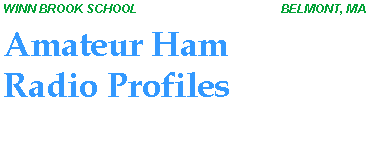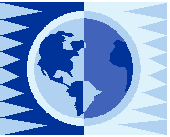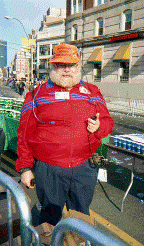

|
PUBLIC SERVICE EVENTS ALS bike ride
HOW I ENDED UP AS A HAM In some ways, the ham radio interest goes back to my grandfather. Recently I learned from my father that when he was a kid his dada made a radio that their family listened to in the evenings, hearing stations from all over the world; I saw something like that radio in an issue of a ham radio magazine from 1932. When my dad was drafted into the navy, he knew enough about radios that put him in a special school to learn how to repair airplane radios. The next person who helped is only a couple of years older than I am: Mike LeFan, WA5EQQ. Mike has been paralyzed since he had polio at age 8. Instead of trying to be barely able to get by with using his arms, Mike concentrated on the one thing he had good control of: his right foot. Mike learned to do so many things that now he runs an internet business, paints pictures, and runs his ham station ... all with his one good foot! He not only got me interested in a hobby where he could have friends all over the world, but he also got me started studying for the ham radio Novice license test. Unfortunately, I had a hard time learning Morse code. Look in ham radio magazines now, and you'll see a lot of mention of Mike: he's in charge of most of the ham radio festivals and conventions in Bell County, Texas. In college I met Dave Wallace, WA1GSF. Dave explained more of the background on the technical side of ham radio and started me searching through more methods to learn Morse code. By the time Dave was done with me, I could have taken the written test and not missed a single question. All that remained was learning the Morse code, which I managed after another 10 years of trying. As a new ham I met others who got me started doing public service events. As the laws changed to make things easier (mostly regarding Morse code), I studied for and passed the exams, first Technician (1986), then General (June, 2000), then Extra class license (August, 2000). In January of 2001, I became a Volunteer Examiner, and now I give the tests instead of taking them.
PUBLIC INFORMATION OFFICER To tell the world about the American Radio Relay League (ARRL) and ham radio, the ARRL has their own group of Public Relations volunteers. In each of the sections of the ARRL, there is a Public Information Coordinator who is assigned to keep in touch with news reporters and keep track of speakers available to clubs in the entire section. Each Public Information Coordinator has a group of Public Information Officers to actually keep track of local events and let reporters know what's going on, and when and where the events will be. Two things led to me being a Public Information Officer: a love of trivia and skill at putting words together. First, I volunteered in 1998 to put together things for an information table at the Boston Amateur Radio Club Field Day. After I had been doing that for a few years, I had an odd experience at the Boston Museum of Science. Someone in the library said there were no ham radio books because there were no exhibits about ham radio. The Space Station exhibit had pictures showing astronauts using their ham radio equipment. When I e-mailed to mention that, I got a request from the Space Station exhibit curator to pass along some information. In two years, that has grown to sending regular ham radio bulletins to the Museum's Current Science and Technology Center about ham radio in space and about ham radio and weather. Just after I started helping the Science Museum, the ARRL Eastern Massachusetts Public Information Coordinator and the ARRL Section Manager talked me into signing on as a Public Information Officer because "you're doing all the work anyway". So now I have a fancy blue badge and a huge library of information that gets used at the Boston Amateur Radio Club Field Day, special science events, and anywhere else I can tell people about what's going on with ham radio. With only three of us covering all of Massachusetts east of Worcester County, the job can get a bit hectic.
©Natasha Bochkov, M.C.S., Martin Bayes, Ph.D., and Donna LaRoche, M.Ed
|
|
Our class friend, Mr. Bill McIninch, KA1MOM, serves as a Public Information Officer for the American Radio Relay League (ARRL). He loves to assist with public service events and is pictured here helping out at the Boston Marathon! |
